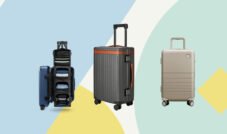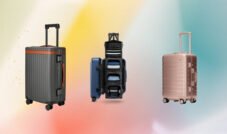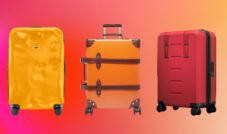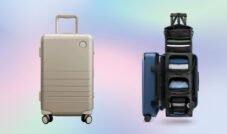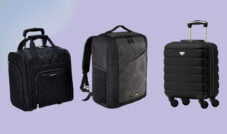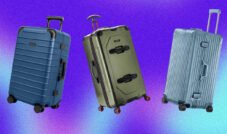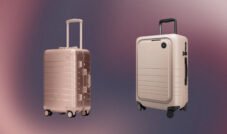Types of Luggage
Before you embark on your quest to find the perfect luggage, it’s essential to understand the various types and styles available. Luggage comes in different forms, each suited to a particular kind of traveler and trip.
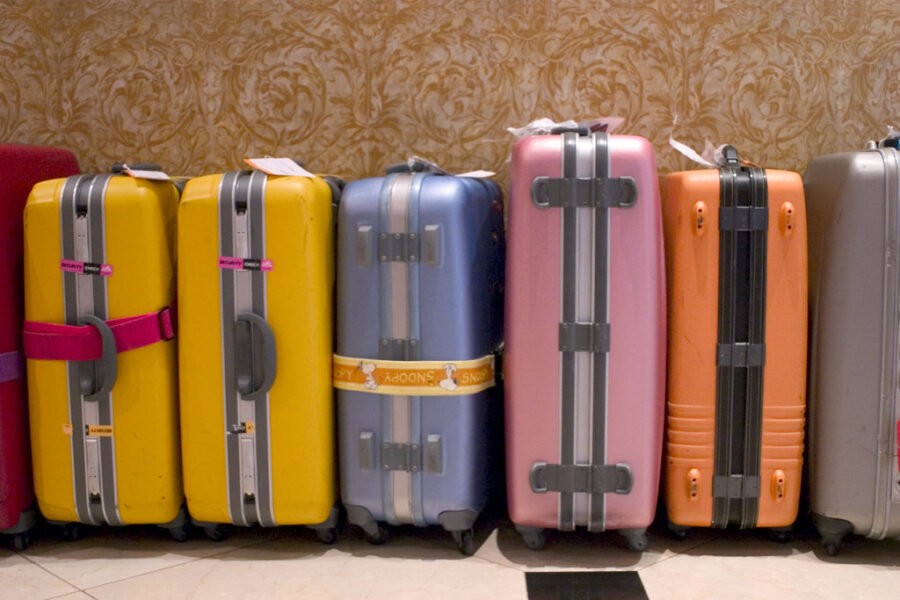
Luggage Styles:
- Rolling Suitcases: The classic suitcase, featuring either two or four wheels, a retractable handle, and a hard or soft shell. These are the most popular choice for many international travelers due to their durability and ample storage space.
- Duffel Bags: A soft, cylindrical bag with handles and often a shoulder strap. Duffel bags are lightweight and versatile, making them great for short trips or adventure travel.
- Backpacks: Ideal for backpackers and those who prefer a hands-free travel experience. They come in various sizes, from daypacks to large travel backpacks.
- Carry-On Bags: Designed to fit airline carry-on size restrictions, these are perfect for travelers who prefer to avoid checked baggage or have short trips.
- Garment Bags: These are designed to keep your clothing wrinkle-free during travel and are typically used for business or formal trips.
- Hardside Luggage: Luggage with a hard outer shell made of materials like polycarbonate or ABS. They offer excellent protection for your belongings.
- Softside Luggage: Luggage with a soft, fabric exterior. They are lighter and often have additional external pockets for extra storage.
See the rest of our best luggage buying guides
- Affordable luggage: best suitcase deals | affordable luggage brands
- Carry-on: carry-on luggage with laptop compartments | easyjet cabin bag |
- Checked luggage: checked luggage for international travel | extra large suitcases | expandable suitcases | trunk luggage
- Durable luggage: most durable luggage | zipperless suitcases | aluminium suitcases
- Luggage brands: luxury luggage brands | European luggage brands | eco-friendly suitcases | luggage with lifetime warranty
- Misc luggage: ultra lightweight suitcases | Tripp suitcases | suitcases for cruises | 2 wheel suitcases | rose gold luggage
- Suitcase reviews: Horizn Studios M5 | Level8 Voyageur | Grams(28) 154 City Pack
- Travel accessories: packing cube alternatives | travel accessories for long flights | compression suitcase packing cubes | GPS luggage tracker | passport covers | travel vanity cases | wine suitcases
The Suitcase vs. Backpack Debate:
One of the first decisions to make is whether you want a traditional suitcase or a backpack. Each has its advantages:
- Suitcase: Provides better organization and protection for fragile items. Easier to access your belongings due to the hinged design. Suitable for travelers who prefer wheels.
- Backpack: Offers more mobility and flexibility, particularly if you’re planning to move around frequently or use public transportation. Great for travelers who want to carry their luggage on their backs.
The Pros and Cons:
- Pros of Suitcases:
- Efficient organization with compartments and dividers.
- Protection for fragile items.
- Ease of rolling on wheels.
- Durability.
- Professional appearance.
- Cons of Suitcases:
- Less mobility in crowded or uneven areas.
- Can be bulky and heavy when fully packed.
- Pros of Backpacks:
- Mobility and freedom to explore.
- Ideal for adventure travel and outdoor activities.
- Often more lightweight and versatile.
- Hands-free experience.
- Cons of Backpacks:
- Limited organization compared to suitcases.
- Potential strain on your back and shoulders if overloaded.
Your choice between a suitcase and a backpack largely depends on your travel style and preferences.
Choosing the Right Size
The size of your luggage is a critical consideration, as it determines how much you can carry and whether your luggage complies with airline restrictions. The ideal size depends on the type of luggage and your specific needs.
Carry-On Luggage:
Carry-on luggage is essential for international travel, allowing you to keep your important belongings with you during the flight. Airlines have specific size restrictions for carry-on bags, so make sure your luggage fits these requirements. Typical dimensions for carry-on luggage are around 21-22 inches in height, 14-18 inches in width, and 8-10 inches in depth. It’s essential to check the guidelines of your chosen airline because restrictions can vary.
Checked Luggage:
For longer trips, you’ll need checked luggage. These can vary widely in size, with larger suitcases typically ranging from 24 to 32 inches in height. Remember that a larger bag means more weight and potential excess baggage fees. Ensure that your checked luggage is large enough to accommodate your needs but not so large that it becomes cumbersome.
Personal Items:
In addition to your main carry-on or checked luggage, most airlines allow a personal item, such as a purse or laptop bag. This extra space can be valuable for carrying essentials like electronics, documents, and other personal items you want to keep close at hand during the flight.
Types of Material
The material of your luggage impacts its durability, weight, and overall performance. The two primary material options are hard shell and soft shell luggage.
Hard vs. Soft Shell Luggage:
- Hard Shell Luggage: This type of luggage is typically made from materials like polycarbonate, ABS, or aluminum. Hard shell luggage offers superior protection for your belongings, making it an excellent choice for fragile items or when you want to safeguard your gear. These materials are also more water-resistant, protecting your belongings in wet conditions. Hard shell luggage often has a sleek, modern appearance.
- Soft Shell Luggage: Soft shell luggage is typically made from durable fabrics like nylon or polyester. These materials are lightweight and flexible, making soft shell luggage ideal for travelers who want to maximize packing space. Soft shell luggage often has external pockets, providing easy access to items like travel documents or a sweater. While they provide less impact protection, soft shell bags can endure rough handling.
Materials to Consider:
- Polycarbonate: Known for its durability and lightweight properties, polycarbonate is a common choice for hard shell luggage. It can withstand rough handling and is resistant to scratches.
- ABS (Acrylonitrile Butadiene Styrene): ABS is another popular hard shell material, offering strength and impact resistance. It is less expensive than polycarbonate but slightly heavier.
- Nylon: A common material for soft shell luggage, nylon is lightweight, durable, and water-resistant. It’s a good choice for travelers who want flexibility and maximum packing space.
- Polyester: Like nylon, polyester is durable and water-resistant. It’s an affordable option for those seeking soft shell luggage.
Your choice between hard shell and soft shell luggage should align with your travel needs and preferences. Consider what you’ll be carrying and the types of trips you’ll be taking.
Wheels and Handles
Wheels and handles are crucial components of luggage, affecting your mobility and convenience while traveling.
Spinner Wheels vs. Inline Wheels:
- Spinner Wheels: Spinner wheels are multi-directional and can rotate 360 degrees. This design offers excellent maneuverability, allowing you to push or pull the luggage in any direction. Spinner wheels are ideal for navigating through crowded airports and tight spaces. They make your luggage feel lighter and more manageable.
- Inline Wheels: Inline wheels are aligned in a straight line, typically on two fixed wheels. While these are less maneuverable than spinner wheels, they are more durable and less prone to damage. Inline wheels are often found on rugged or heavy-duty luggage.
Telescoping Handles:
A sturdy, adjustable telescoping handle is essential for a smooth travel experience. Look for handles that extend to a comfortable height for you. Also, check the durability of the handle mechanism, as flimsy handles can become a hassle.
When choosing your luggage, consider the wheels and handles carefully, as they can significantly impact your ability to move through airports, train stations, and various travel environments.
Security Features
Security is a paramount concern when it comes to luggage. Travelers want to ensure their belongings are safe throughout their journey.
Locks and Zippers:
Most luggage comes with built-in zippers and combination locks. These locks provide a basic level of security and help deter casual theft. However, it’s important to note that zippers can be forced open with enough effort. For added security, consider luggage with lockable zippers that can be used with a small padlock. Keep in mind that if you choose this option, ensure the lock is TSA-approved to avoid damage during security inspections.
Built-in Locks:
Some high-end luggage models come with integrated combination locks. These locks provide a more secure way to protect your belongings. They are built directly into the frame of the luggage and can offer an additional layer of security.
Consider the security features that are most important to you and the level of protection your luggage provides, especially if you are carrying valuable or sensitive items.
Durability and Quality
The durability and quality of your luggage are significant factors in your choice. Durable luggage is more likely to withstand the rigors of international travel and last for many trips to come.
Warranty and Reputation:
Check the warranty provided by the luggage manufacturer. A longer warranty period typically indicates confidence in the product’s durability. Reputable luggage brands often stand by their products with generous warranties. Additionally, consider the brand’s reputation, as established brands are more likely to offer higher-quality luggage.
Consumer Reviews:
Reading consumer reviews can provide valuable insights into the durability and quality of luggage. Real-world experiences from other travelers can help you understand how a particular bag performs in different travel scenarios. Look for luggage with positive reviews regarding durability, material quality, and construction.
Before making your purchase, thoroughly research the durability and quality of your chosen luggage to ensure it meets your needs and expectations.
Consider Your Destination
Different trips call for different types of luggage. Consider your destination and the nature of your travel when choosing luggage.
Different Luggage for Different Trips:
- City Travel: For urban destinations, consider wheeled luggage like a rolling suitcase for easy navigation through streets and airports. A lightweight carry-on may be suitable for short city breaks.
- Adventure Travel: If your international travel involves outdoor activities, you might prefer a durable backpack or a rugged duffel bag that can withstand the elements.
- Business Travel: For professional trips, a garment bag or a stylish rolling briefcase may be the best choice to keep your business attire wrinkle-free.
Special Considerations:
- Cruises: Some cruise lines have specific luggage requirements, so be sure to check in advance. For cruises, durable and secure luggage with a bit of formality is ideal.
- Backpacking: If you’re planning on backpacking through multiple countries, a high-quality travel backpack with adjustable straps and plenty of pockets can be a versatile choice.
- Ski or Snowboard Trips: Specialized ski or snowboard bags are essential for protecting your gear. These are designed to accommodate the size and weight of your equipment.
Customize your luggage choice to match the unique demands of your destination and travel style.
Budget Considerations
Your budget is a significant factor when choosing luggage. Luggage prices can vary widely, from budget-friendly options to high-end, luxury brands. While a more expensive bag may offer advanced features and exceptional durability, you can still find quality luggage that fits your budget.
Quality vs. Cost:
- Budget Luggage: Affordable luggage can be suitable for occasional travelers or those on a tight budget. While budget luggage may not have all the features of higher-end models, it can provide a cost-effective solution for less frequent travelers.
- Mid-Range Luggage: Luggage in the mid-range offers a good balance of quality and cost. These bags typically provide durability, practical features, and a reasonable price point. They are suitable for most travelers.
- Premium Luggage: Premium luggage brands offer top-tier materials, advanced security features, and extensive warranties. If you are a frequent traveler or prioritize high-quality luggage, premium options may be worth the investment.
Consider your budget and balance it with your travel needs and frequency. Keep in mind that a slightly higher upfront investment in quality luggage can save you money in the long run by lasting through many trips.
What to Avoid When Buying Luggage
In your quest for the perfect luggage, it’s crucial to avoid common mistakes and potential pitfalls. Here are some key points to steer clear of:
Common Mistakes:
- Choosing the Wrong Size: Avoid selecting luggage that’s either too large or too small for your needs. Ensure your luggage complies with airline size restrictions.
- Ignoring Weight Restrictions: Be aware of the weight limits for both carry-on and checked luggage imposed by airlines to avoid excess baggage fees.
- Neglecting Quality and Durability: Low-quality luggage may save you money upfront, but it can lead to frustration and extra expenses in the long run. Invest in durable luggage from reputable brands.
- Overlooking Warranty: A generous warranty indicates the manufacturer’s confidence in the product’s durability. Avoid luggage with limited or no warranties.
Warning Signs of Low-Quality Luggage:
- Flimsy Zippers: Luggage with poor-quality zippers can break easily, leaving your belongings vulnerable.
- Weak Stitching: Inspect the seams and stitching of the luggage to ensure they are strong and well-constructed.
- Cheap Materials: Low-quality materials can lead to damaged or torn luggage. Pay attention to the material’s thickness and overall quality.
- Non-Secure Locks: Inadequate or non-secure locks provide minimal protection for your belongings. Look for luggage with dependable lock features.
Avoiding these common mistakes and paying attention to the warning signs of low-quality luggage can save you from future travel hassles and inconveniences.
Packing Tips for International Travel
Once you’ve selected the perfect luggage, it’s equally important to know how to pack efficiently for your international journey. Here are some packing tips to make the most of your luggage’s space:
Maximizing Space:
- Roll Your Clothes: Rolling your clothes instead of folding them can save space and reduce wrinkles.
- Use Packing Cubes: Packing cubes help you organize your clothing and maximize space within your luggage.
- Pack Versatile Items: Bring clothing that can be mixed and matched to create various outfits.
- Utilize Compression Bags: Compression bags remove excess air and reduce the volume of bulky clothing.
Packing Essentials:
- Travel Documents: Organize your passport, visa, and travel insurance documents in a secure and accessible place.
- Electronics: Pack chargers, adapters, and power banks for your electronic devices.
- Travel Toiletries: Bring travel-sized toiletries or reusable containers to save space.
- First Aid Kit: Carry a basic first aid kit with essentials like pain relievers and bandages.
- Entertainment: Bring books, magazines, or electronic entertainment to keep you occupied during travel.


